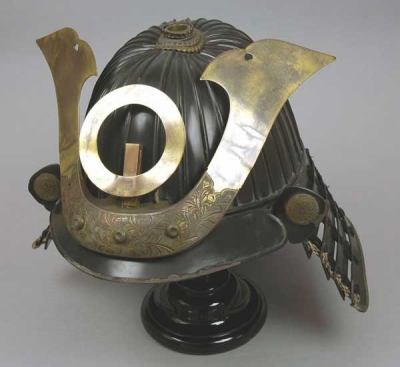Helmet (1922.37.2.1.11)
 JapanHelmet from Japan, Asia. Owned by Lucy Markby by 1897. Given to the Museum in 1922.
JapanHelmet from Japan, Asia. Owned by Lucy Markby by 1897. Given to the Museum in 1922.
This Japanese helmet dates to around 1700 and features a horned crest and circular Buddhist halo.
The Beautiful Warrior
This helmet is simpler in style than many other Japanese examples but it is of very high quality workmanship and is loaded with symbolism and meaning. This particular type of helmet is known as a suji-hachi, that uses the highest number of segments (32) in its construction. This technique allowed the armourer to vary the shape of the helmets he made to an enormous extent, sometimes so that they were 'made to fit' the individual.
The turn-backs or fukigaeshi, which prevented the wearer from receiving slashing downward cuts to his face, are small and in the later style. They bear a round kamon or family badge, here cast in the form of a single wisteria frond. The main lacing of the helmet parts is in the most popular dark blue silk braid but the ear-cord features white, green, purple and blue. Braiding tended to be in one, three or four colours but rarely two. This is because the term for two colours, 'ni-ke' sounded too much like 'nige', which meant, 'to flee'. Any connection to the notion of cowardice was avoided.
The large ornamental rivets of the helmet are modelled in the form of chrysanthemum flowers, the Imperial symbol of the Emperor. The helmet horns, and Buddhist halo at the front have been cut from a sheet of copper, and gilded. On this example it is easy to see where the gilding has worn away. People have disagreed over the meaning of the horns, but they seem to depict the unfolding leaves of the omodaka plant, which is also known as 'victory grass'.
In conclusion, the features of the helmet can be identified as bringing the warrior good luck or divine assistance, symbolising the identity of his family or illustrating his allegiance to the Emperor. Others are purely aesthetic and reflect the same concern seen in many fine pieces of Japanese arms and armour: the beautification of their owner. Many armours of the long, peaceful Tokugawa period (1603-1867) are particularly ornate, and reflect the fact that high-class warriors wore them on public parades.





